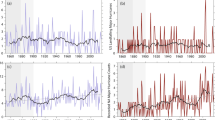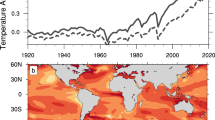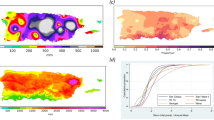Abstract
Replying to: U. Neu Nature 451, 10.1038/nature06576 (2008).
Neu1 suggests that the reconstruction of Atlantic major hurricane activity (MHA) (that is, frequency) in Nyberg et al.2 overestimates past MHA because it differs significantly from the known observational records of tropical storms and MHA3 before 1945 and overestimates the influence of vertical windshear |Vz|.
Similar content being viewed by others
Main
Neu1 claims that the variability of the historical tropical storm record3 is accurate and provides an alternative reconstruction of MHA from 1851 to 1910 based on assumptions of low numbers (according to refs 4 and 5) of non-observed tropical storms, and a stable ratio between total number of tropical storms and MHA over the long term. However, Neu’s record shows a sudden rise in MHA around 1944, coincident with the start of aircraft reconnaissance, which allowed much better monitoring of tropical cyclones. Also, according to ref. 4, the undercount bias is up to six tropical cyclones per year between 1851 and 1885, and up to four per year between 1886 and 1910. These biases are higher than the ones Neu1 uses in his record of major hurricane numbers. Furthermore, to quote from ref. 4, “conclusions from this paper on the number of missed tropical cyclones are likely conservative”. Moreover, MHA shows a stronger variability, closely correlated to |Vz| (ref. 2), than tropical storms and non-major hurricanes in the reliable record1,2,3 indicating a varying MHA/tropical storm ratio back in time.
The reconstruction in ref. 2 is based on proxies of |Vz| (also, for example, sea-level pressures, lower atmospheric stability and moisture) and independent sea-surface temperature (SST) records. In contrast to Neu’s1 claims, no significant trends are apparent during the calibration period2 between ∼1969 and the late 1980s, either in the observed number of major hurricanes1,2,3 or in the measured |Vz|, whereas there is a significant trend of increasing SSTs in and around the main development region (MDR). This lack of a direct response of an increase in MHA from the increases in SSTs indicates the strong influence of |Vz|, and interactively caused SST anomalies in MDR relative to tropical mean SSTs, on MHA. Moreover, the MHA record1,2,3 shows no appreciable difference in numbers of major hurricanes between the periods 1948–1952 (average of 3.8 major hurricanes) and 1995–2006 (average of 3.9 major hurricanes), despite the fact that SSTs were more than ∼0.4 oC higher in and around the MDR during the latter period. The ∼1.5 m s-1 higher vertical wind shear in MDR during this period2 indicates the dampening effect of |Vz| on MHA.
A conclusion in ref. 2 is that the average number of major hurricanes in the Atlantic during the period from 1995 to 2005 is not unusual when compared to previous high-activity phases, also supported by Fig. 1 in Neu1 and by refs 6 and 7. Reference 2 does not say that the recent increases in SSTs have no influence on MHA. A comparison of present values of |Vz| with reconstructed values back to 1730 shows that the |Vz| was high from 1995 to 2005, but that although it decreased from the late 1980s it should still have dampened MHA. Thus, high MHA suggests the net result of higher SSTs overcoming the effect of high |Vz|.
The trade wind strength (|Vz|) in MDR is affected by the Atlantic subtropical high through an equatorward meridional pressure gradient8,9,10,11. Thus, the combined proxies may reflect a trend since the mid–late 18th century of an intensified and poleward Hadley cell circulation, where the proxies from the northern Caribbean reflect the strengthening of the subtropical high and trade winds12 (which from the late 1960s to the late 1980s were anomalously strong13) and the associated increasing subsidence caused by a faster warming of the atmosphere than ocean2, which together may have suppressed MHA. Also, these seasonal precipitation proxies reflect warm-phase El Niño Southern Oscillation (ENSO) events, which cause upper westerly winds, additional wind shear in MDR, and an equatorward shift of the subtropical jet stream that suppress MHA9 and precipitation10,11 during the hurricane season. These events were frequent from the mid 1970s to the early 1990s.
The proxies used in ref. 2 reflect the region where almost all Atlantic major hurricanes form (see Fig. 2 of ref. 2), and the non-linear solution2 allows for varying MHA in response to |Vz| and other influences such as SSTs. Absolute MHA values may change slightly given different model calibrations, but the proxies2 still indicate a declining trend in MHA until the early 1990s superimposed on decadal and multi-decadal variability and that the conclusions in Nyberg et al2 remain.
References
Neu, U. Is recent major hurricane activity normal? Nature 451 10.1038/nature06576 (2008)
Nyberg, J. et al. Low Atlantic hurricane activity in the 1970s and 1980s compared to the past 270 years. Nature 447, 698–701 (2007)
Best track data of the NOAA National Hurricane Center (HURDAT). 〈http://www.aoml.noaa.gov/hrd/hurdat/Data_Storm.html〉 (data used as published 11 June 2007). (Hurricane Research Division, US National Oceanic and Atmospheric Administration.)
Landsea, C. W. Counting Atlantic tropical cyclones back to 1900. Eos 18, 197–208 (2007)
Landsea, C. W. et al. in Hurricanes and Typhoons: Past, Present and Future (eds Murname, R. J. & Liu, K.-B.) 177–221 (Columbia Univ. Press, New York, 2004)
Swanson, K. L. Impact of scaling behavior on tropical cyclone intensities. Geophys. Res. Lett. 34, L18815 (2007)
Miller, D. L. et al. Tree-ring isotope records of tropical cyclone activity. Proc. Natl Acad. Sci. USA 103, 14294–14297 (2006)
George, S. E. & Saunders, M. A. North Atlantic oscillation impact on tropical north Atlantic winter atmospheric variability. Geophys. Res. Lett. 28, 1015–1018 (2001)
Aiyyer, A. R. & Thorncroft, T. Climatology of vertical wind shear over the tropical Atlantic. J. Clim. 19, 2969–2983 (2006)
Giannini, A., Cane, M. A. & Kushnir, Y. Interdecadal changes in the ENSO teleconnection to the Caribbean region and the North Atlantic Oscillation. J. Clim. 14, 2867–2879 (2001)
Jury, M., Malmgren, B. A. & Winter, A. Subregional precipitation climate of the Caribbean and relationships with ENSO and NAO. J. Geophys. Res. 112, D16107 (2007)
Hoerling, M. P., Hurrell, J. W. & Xu, T. Tropical origins for recent North Atlantic climate change. Science 292, 90–92 (2001)
Osborn, T. N. et al. Evaluation of the North Atlantic oscillation as simulated by a coupled climate model. Clim. Dyn. 15, 685–702 (1999)
Author information
Authors and Affiliations
Rights and permissions
About this article
Cite this article
Nyberg, J., Malmgren, B., Winter, A. et al. Nyberg et al. reply. Nature 451, E6 (2008). https://doi.org/10.1038/nature06577
Issue Date:
DOI: https://doi.org/10.1038/nature06577
Comments
By submitting a comment you agree to abide by our Terms and Community Guidelines. If you find something abusive or that does not comply with our terms or guidelines please flag it as inappropriate.



